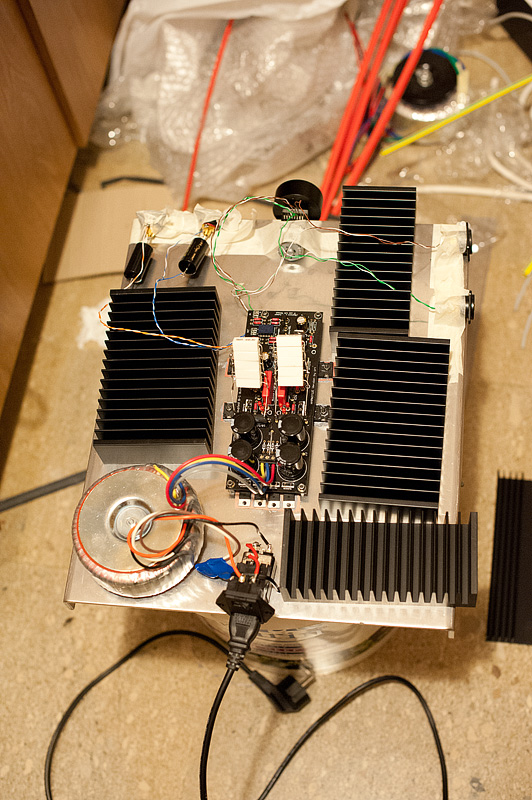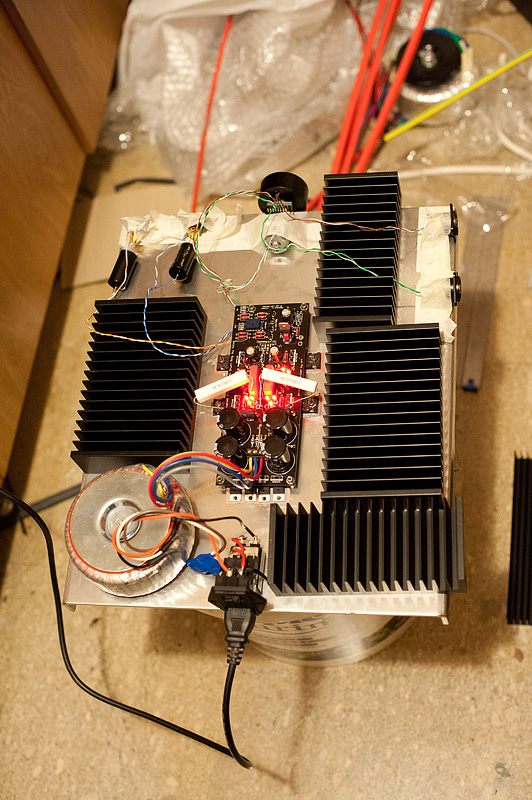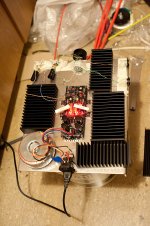It' s a 40cm x 40cm aluminum plate 5mm thick and with around 3cms bent on the two sides to allow for easier mounting of side walls. It is very nice quality. Heavy and shinny. It even came with a sticky protective sheet on one side to prevent it from getting scratched.
I was planning to use them on my F5 monoblocks, but I always get some surplus 🙂

I was planning to use them on my F5 monoblocks, but I always get some surplus 🙂

OK as promised here are some more photos from the current status
Here is the board with the 5x5R @5W resistors attached in parallel to the 10R Mills.

You can also see the additional heatsinks just thrown in there not firmly attached. The two bigger ones will go to left and right, and the two smaller ones will go top and bottom.
I also got two additional ones (you can see part of them on the right on the floor) that will go to the bottom of the plate and be attached using the same screws with the fets.
And here is another one with the lights on as it is now. Replaced the resistors with 1R @10W. Those still get pretty hot though....

Current measurements are
CCS resistance ~0R9
CCS current ~1,2A
With the single resistors and after hearing a song or two, I believe the thinness was fixed a bit. Still pretty early to make any serious comments with the freshly soldered parts. Anyway. just do not do any critical listening with chunks of cement resistors attached.
Here is the board with the 5x5R @5W resistors attached in parallel to the 10R Mills.
You can also see the additional heatsinks just thrown in there not firmly attached. The two bigger ones will go to left and right, and the two smaller ones will go top and bottom.
I also got two additional ones (you can see part of them on the right on the floor) that will go to the bottom of the plate and be attached using the same screws with the fets.
And here is another one with the lights on as it is now. Replaced the resistors with 1R @10W. Those still get pretty hot though....
Current measurements are
CCS resistance ~0R9
CCS current ~1,2A
With the single resistors and after hearing a song or two, I believe the thinness was fixed a bit. Still pretty early to make any serious comments with the freshly soldered parts. Anyway. just do not do any critical listening with chunks of cement resistors attached.
Attachments
Quick question. How hot are the 1R resistors supposed to run? The 10W ones I have, got pretty hot quickly. An hour later they were at around 70C
Quick question. How hot are the 1R resistors supposed to run? The 10W ones I have, got pretty hot quickly. An hour later they were at around 70C
In your situation, I would read the spec sheet for that resistor from that vendor.
70c for a power resistor is usually okay.
I doubt there is such a thing. Even if I knew the vendor. They are just unbranded plain cheap blocks bought from a local shop.
Nominal resistor power when it is at least 3x the actual power dissipated keeps an honestly characterized resistor safe in the long run. Ventilation and orientation come into play too. There is a chart in well documented types that shows the derating with rising temp.
So is it normal to have ~70C in those with only ~1,2W ?
If so it' s also not a good idea to keep them so close to the filter caps too
If so it' s also not a good idea to keep them so close to the filter caps too
Its 12W actually when having 1.2A through and 10V across each. 70C on the internal silicone die is safe. That means 50C on their cases you stick the thermocouple at in your config. For capacitors you gain life time inversely proportional to the ambient they live in. Double their half rated lifetime for each 10C less than their temp rating and add it up.
Its 12W actually when having 1.2A through and 10V across each.
Isn't it 1,2V across them?
No, its whatever your transfo and bridge gives minus Vout across the CCS one (drain to source) and Vout (~10V) across the output one. For your setting resistor its dissipation is its voltage drop times what it runs. 1.2A now.
In that case we need to correct the ratings specified on the posts for hotrod stages.
20W+ will quickly roast the 12W 1Rs specified for the stage 3 (2A).
20W+ will quickly roast the 12W 1Rs specified for the stage 3 (2A).
The 20W will be on each Mosfet not on each setting resistor. We should only note that different leds or Mosfet batches may ask for lower than 1 Ohm to reach 2A.
The 20W will be on each Mosfet not on each setting resistor. We should only note that different leds or Mosfet batches may ask for lower than 1 Ohm to reach 2A.
So what wattage resistors will be needed for 2As?
I am asking because if we need 12W for 1,2A (10V across), I would expect something around 20W for 2A
I don't know what you are expecting at over 1 amp... You're risking big time malfunction and something bad to happen to your audio equipment... Can you really hear a difference over 600-800mA?
Have fun!
Do
Have fun!
Do
So what wattage resistors will be needed for 2As?
I am asking because if we need 12W for 1,2A (10V across), I would expect something around 20W for 2A
#2370 I already wrote that the resistor dissipation is just what voltage is on the actual resistor times the set current. Measure your set resistor pin to pin, what is it? 1.2-1.4V now that you are set at 1.2A?
If you will burn say 4W on a self sinking resistor, 12W to 15W nominal will be safe. I would not recommend less than 3x for long term reliability because it heats up on 100% cycle due to constant current operation.
I don't know what you are expecting at over 1 amp... You're risking big time malfunction and something bad to happen to your audio equipment... Can you really hear a difference over 600-800mA?
Have fun!
Do
He uses an output coupling capacitor.
#2370 I already wrote that the resistor dissipation is just what voltage is on the actual resistor times the set current. Measure your set resistor pin to pin, what is it? 1.2-1.4V now that you are set at 1.2A?
That s what I thought, but I got confused from #2368 to #2370 where I asked if it was the measured 1,2V and you told me no it was 10V and 12W.
Anyway 🙂
So it's currently 1,1V x 1,2A = 1,32W on the resistors.
My initial question was if that 1,32W is enough to make 10W resistors run so hot? 70C on the cement body?
@Pinnocchio
Yes there is a difference, but I think 1-1,2A will be my limit mostly for practical reasons like heatsinking limitations and as you say general reliability and safety.
In DC duty cycle, yes a cement self sinking box can accumulate temp. You experienced it yourself on those 10W of yours, didn't you?
P.S. I thought you were asking about the 70C estimated internal temp of IRF240-9240 I had analyzed before that.
P.S. I thought you were asking about the 70C estimated internal temp of IRF240-9240 I had analyzed before that.
- Home
- Source & Line
- Analog Line Level
- Salas hotrodded blue DCB1 build

